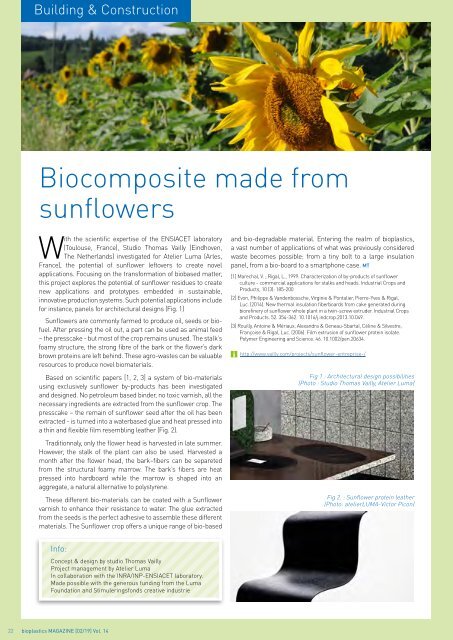Issue 02/2019
Highlights: Thermoforming Building & Construction Basics: Biobased Packaging
Highlights:
Thermoforming
Building & Construction
Basics: Biobased Packaging
You also want an ePaper? Increase the reach of your titles
YUMPU automatically turns print PDFs into web optimized ePapers that Google loves.
Building & Construction<br />
Biocomposite made from<br />
sunflowers<br />
With the scientific expertise of the ENSIACET laboratory<br />
(Toulouse, France), Studio Thomas Vailly (Eindhoven,<br />
The Netherlands) investigated for Atelier Luma (Arles,<br />
France), the potential of sunflower leftovers to create novel<br />
applications. Focusing on the transformation of biobased matter,<br />
this project explores the potential of sunflower residues to create<br />
new applications and prototypes embedded in sustainable,<br />
innovative production systems. Such potential applications include<br />
for instance, panels for architectural designs (Fig. 1)<br />
Sunflowers are commonly farmed to produce oil, seeds or biofuel.<br />
After pressing the oil out, a part can be used as animal feed<br />
– the presscake - but most of the crop remains unused. The stalk’s<br />
foamy structure, the strong fibre of the bark or the flower’s dark<br />
brown proteins are left behind. These agro-wastes can be valuable<br />
resources to produce novel biomaterials.<br />
Based on scientific papers [1, 2, 3] a system of bio-materials<br />
using exclusively sunflower by-products has been investigated<br />
and designed. No petroleum based binder, no toxic varnish, all the<br />
necessary ingredients are extracted from the sunflower crop. The<br />
presscake – the remain of sunflower seed after the oil has been<br />
extracted - is turned into a waterbased glue and heat pressed into<br />
a thin and flexible film resembling leather (Fig. 2).<br />
Traditionnaly, only the flower head is harvested in late summer.<br />
However, the stalk of the plant can also be used. Harvested a<br />
month after the flower head, the bark–fibers can be separeted<br />
from the structural foamy marrow. The bark’s fibers are heat<br />
pressed into hardboard while the marrow is shaped into an<br />
aggregate, a natural alternative to polystyrene.<br />
These different bio-materials can be coated with a Sunflower<br />
varnish to enhance their resistance to water. The glue extracted<br />
from the seeds is the perfect adhesive to assemble these different<br />
materials. The Sunflower crop offers a unique range of bio-based<br />
and bio-degradable material. Entering the realm of bioplastics,<br />
a vast number of applications of what was previously considered<br />
waste becomes possible: from a tiny bolt to a large insulation<br />
panel, from a bio-board to a smartphone case. MT<br />
[1] Marechal, V. ; Rigal, L., 1999. Characterization of by-products of sunflower<br />
culture - commercial applications for stalks and heads. Industrial Crops and<br />
Products, 10 (3): 185-200<br />
[2] Evon, Philippe & Vandenbossche, Virginie & Pontalier, Pierre-Yves & Rigal,<br />
Luc. (2014). New thermal insulation fiberboards from cake generated during<br />
biorefinery of sunflower whole plant in a twin-screw extruder. Industrial Crops<br />
and Products. 52. 354-362. 10.1016/j.indcrop.2013.10.049.<br />
[3] Rouilly, Antoine & Mériaux, Alexandra & Geneau-Sbartaï, Céline & Silvestre,<br />
Françoise & Rigal, Luc. (2006). Film extrusion of sunflower protein isolate.<br />
Polymer Engineering and Science. 46. 10.10<strong>02</strong>/pen.20634.<br />
http://www.vailly.com/projects/sunflower-entreprise-/<br />
Fig 1 : Architectural design possibilities<br />
(Photo : Studio Thomas Vailly, Atelier Luma)<br />
Fig 2. : Sunflower protein leather<br />
(Photo: atelierLUMA-Victor Picon)<br />
Info:<br />
Concept & design by studio Thomas Vailly<br />
Project management by Atelier Luma<br />
In collaboration with the INRA/INP-ENSIACET laboratory.<br />
Made possible with the generous funding from the Luma<br />
Foundation and Stimuleringsfonds creative industrie<br />
22 bioplastics MAGAZINE [<strong>02</strong>/19] Vol. 14


















